Cosmology
1/95
There's no tags or description
Looks like no tags are added yet.
Name | Mastery | Learn | Test | Matching | Spaced |
|---|
No study sessions yet.
96 Terms
The astronomical unit (AU) is defined as:
The mean distance from the centre of the Earth to the centre of the Sun
Why is the value a mean?
the Earth’s orbit around the Sun is elliptical it will be slightly closer to the Sun in January (1.471 × 1011 m) than it is in July (1.521 × 1011 m)
What is one AU?
1.496 × 1011 m ≈ 1.5 × 1011 m
A light-year is defined as:
distance travelled by light in one year
parsec is defined as:
A unit of distance that gives a parallax angle of 1 second of an arc (of a degree), using the radius of the Earth’s orbit (1 AU) as the baseline of a right–angled triangle

Angles smaller than 1 degree can be measured in arcminutes or arcseconds
1 degree = 60 arcminutes
1 arcminute = 60 arcseconds
Therefore, 1 degree = 60 x 60 = 3600 arcseconds
1 arcsecond = 1/3600 degree
Given that 1 AU = 1.496 × 1011 m, trigonometry can be used to express 1 parsec in metres:

1 AU =
1.496 × 1011 m
Stellar Parallax is defined as:
The apparent shifting in position of a nearby star against a background of distant stars when viewed from different positions of the Earth, during the Earth’s orbit about the Sun
(It involves observing how the position of a nearby star changes over a period of time against a fixed background of distant stars. To an observer the position of distant stars does not change with time)
If a nearby star is viewed from the Earth in _____ and again in ____, when the Earth is at a different position in its orbit around the Sun, the star will appear in different positions against a backdrop of distant stars which will appear to not have moved
January
July
What is this apparent movement of nearby stars called?
stellar parallax
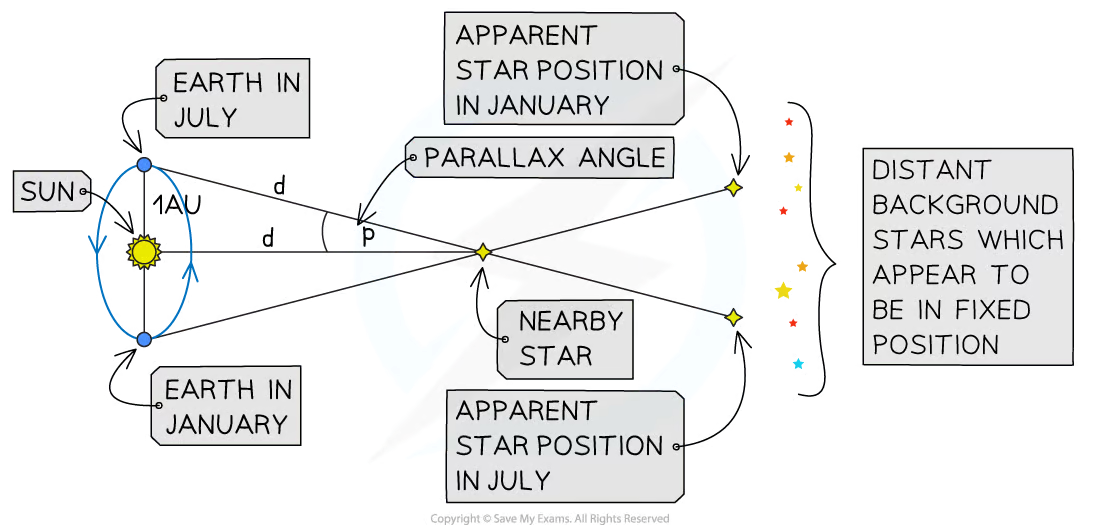
Applying trigonometry to the parallax equation: (not given)
1 AU = radius of Earths orbit around the sun
p = parallax angle from earth to the nearby star
d = distance to the nearby star
So, tan(p) = 1 AU/d
small angles, expressed in radians, tan(p) ≈ p, therefore: p = 1 AU/d
If the distance to the nearby star is to be measured in parsec, then it can be shown that the relationship between the distance to a star from Earth and the angle of stellar parallax is given by:
p = 1/d
p = parallax (")
d = the distance to the nearby star (pc)
What is this equation accurate up till and why?
distances of up to 100 pc
For distances larger than 100 pc the angles involved are so small they are hard to measure accurately

1 arcminute is denoted by __
1'
1 arcsecond is denoted by __
1"
The cosmological principle states that:
The universe is isotropic, homogenous and the laws of physics are universal
What is isotropic?
means that the universe is the same in all directions to every observer
Although specific regions of space may be completely empty and other regions may contain galaxies or clusters of galaxies which clump together, over the entire volume of space the distribution of matter appears to be uniform
What does homogenous mean?
means that matter is uniformly distributed, the universe has a uniform density
Although specific regions of space may contain more matter and other regions may contain less matter, over the entire volume of space the density appears uniform
What does at every point in the universe the laws of physics are universal?
means that the same laws and models apply as here on Earth
The Cosmological Principle is demonstrated using the three models of the universe:
Model A shows a universe that is isotropic, but not homogenous
The universe is the same in all directions to every observer
However, there is not a uniform distribution of matter (uniform density) in all regions
Model B shows a universe that is homogenous, but not isotropic
The universe has a uniform distribution of matter (uniform density) in all regions
However, the universe is not the same in all directions to every observer due to the orientation of the bricks
Model C illustrates the Cosmological Principle, it is both isotropic and homogenous
The universe is the same in all directions to every observer
The universe has a uniform distribution of matter (uniform density) in all regions
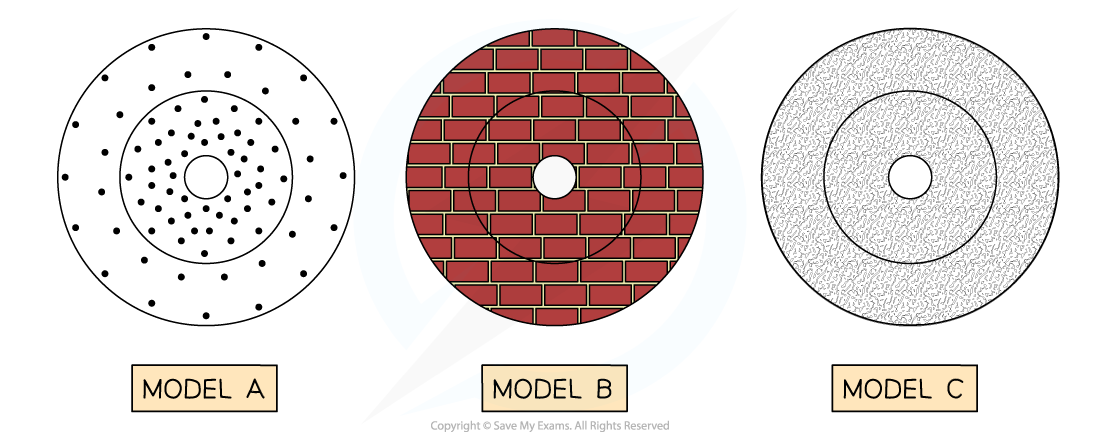
What is the doppler effect?
If a wave source is stationary, the wavefronts spread out symmetrically
If the wave source is moving, the waves can become squashed together or stretched out
If the wave source is moving towards an observer the wavefronts will appear _____
If the wavefront is moving away from an observer the wavefronts will appear ______
squashed
stretched out
What observed qualities does this therefore change?
frequency and wavelength
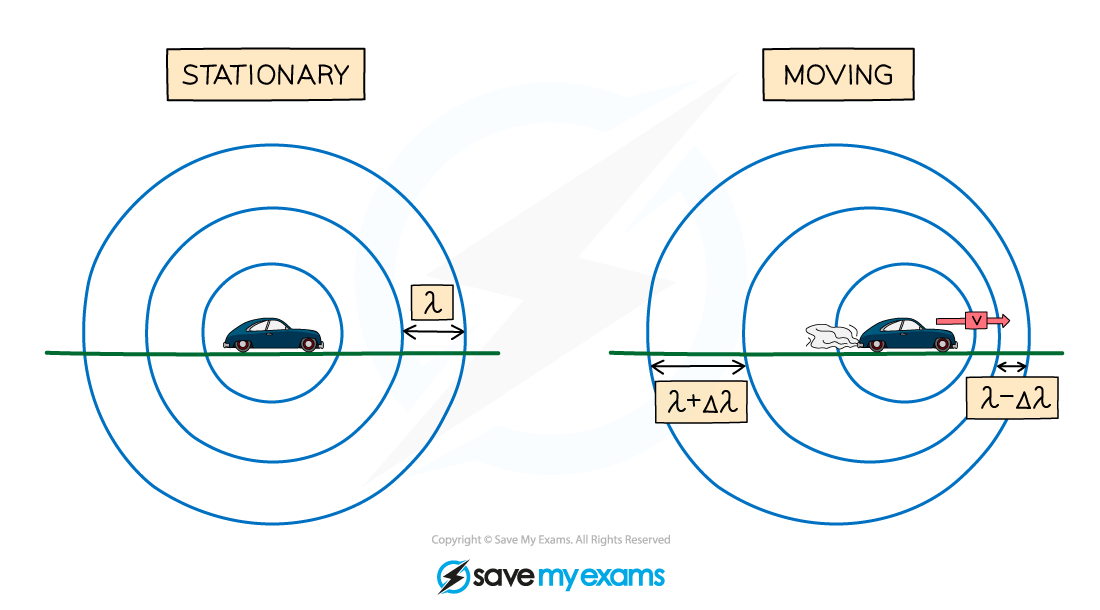
A moving object will cause the wavelength, λ, (and frequency) of the waves to change:
The wavelength of the waves in front of the source decreases (λ – Δλ) and the frequency increases
The wavelength behind the source increases (λ + Δλ) and the frequency decreases
However:
The actual wavelength emitted by the source remains the same
It is only the wavelength that is received by the observer that appears to have changed
Doppler effect is defined as:
The apparent shift in wavelength occurring when the source of the waves is moving
Doppler effect, or Doppler shift, can be observed using any form of _______
EM rad
Why can the doppler effect be observed by comparing the light spectrum produced from a close object, such as our Sun, with that of a distant galaxy?
The light from the distant galaxy is shifted towards the red end of the spectrum (There are more spectral lines in the red end)
This provides evidence that the universe is expanding

Doppler shift (Doppler effect) describes how the wavelength (or frequency) of waves change when ______
the source of the waves and observer are moving relative to each other
If the relative speed between the source of the waves and the observer, ∆v, is small compared to the speed at which the wave is travelling, c, then the Doppler wavelength shift, ∆λ, and frequency shift, ∆f, is given by (given):
Δv = relative speed between source and observer (m s–1)
c = speed of the wave (m s–1)
Δf = observed change in frequency between moving source and stationary source of wave (Hz)
f = unshifted frequency of the wave emitted (Hz)
Δλ = observed change in wavelength between moving source and stationary source of wave (m)
λ = unshifted wavelength of the wave emitted (m)

relative speed between source and observer along the line joining them is give by (learn):
∆v = vs – vo
vs = velocity of electromagnetic waves source
vo = velocity of observer
Usually, we are calculating the speed of the source of electromagnetic waves relative to an observer which we assume to be stationary
Therefore vo = 0, hence ∆v = vs = v
Where v is the velocity at which the source of the electromagnetic waves is moving from the observer
Hence, the Doppler shift equation can therefore be written as:

red light has the _____ wavelength and the ______ frequency
longest
smallest
What is the type of light with shorter wavelength and higher frequency?
blue light
How did astronomer Edwin Hubble (1929) show the universe was expanding?
He did this by observing that the absorption line spectra produced from the light of distant galaxies was shifted towards the red end of the spectrum
This doppler shift in the wavelength of the light is evidence that distant galaxies are moving away from the Earth
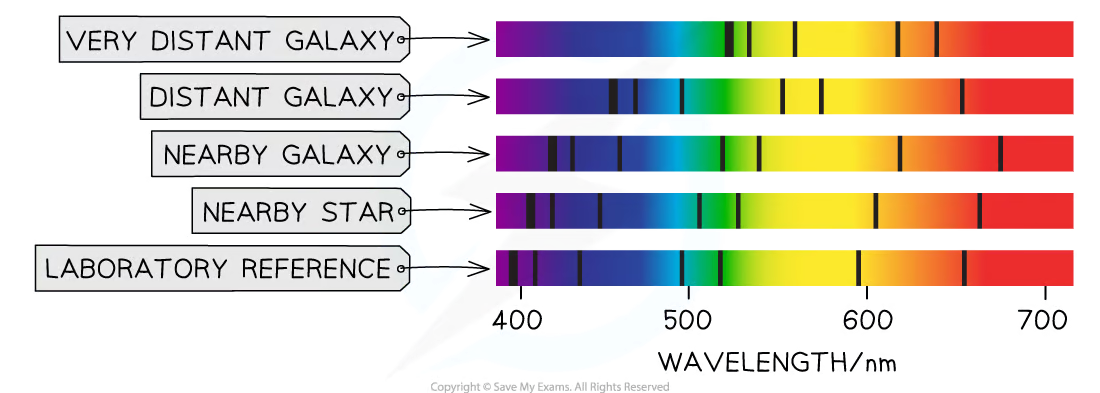
What did light from more distant galaxies being shifted further towards the red end of the spectrum compared to closer galaxies show?
concluded: galaxies or stars further away from the Earth are moving faster than galaxies which are closer
Hubble’s law states:
The recessional velocity, v, of a galaxy is proportional to its distance from Earth
v ≈ H0d (given)
v ≈ H0d units
v = recessional velocity of an object, the velocity of an object moving away from an observer (km s-1)
H0 = Hubble constant, this will be provided in your examination along with the correct units (km s-1 Mpc-1)
d = distance between the object and the Earth (Mpc)
This Hubble’s law shows:
The further away a star is from the Earth, the faster it is moving away from us
The closer a star is to the Earth, the slower it is moving away from us
Why is it difficult to be certain about just how accurate the values for the Hubble constant are?
random and systematic errors involved when calculating the distance to a galaxy or star
Astronomers have concluded from hubble that:
All galaxies are moving away from the Earth
Galaxies are moving away from each other
Distant galaxies are receding faster than closer galaxies
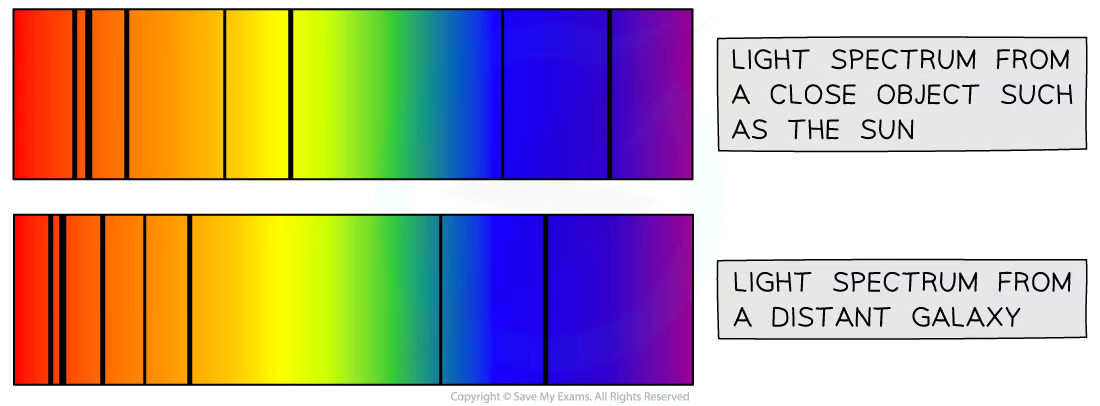
What does this diagram show:
Light coming to the Earth from a close object, such as the Sun,
Light coming to the Earth from a supernovae in a distant galaxy
Why when Red-shift is observed when the spectral lines from the distant galaxy move closer to the red end of the spectrum?
This is because light waves are stretched by the expansion of the universe so the wavelength increases (or frequency decreases)
This indicates that the galaxies are receding (moving away) from us
The fact the galaxies are moving further apart is what we would expect after an ______
explosion
Matter is first _______ and as it explodes it moves out in all directions getting further and further from the source of the explosion
Some matter will be lighter and travel at a ____ speed, further from the source of the explosion
Some matter will be heavier and travel at a _____ speed, closer to the source of the explosion
densely packed
greater
slower
Around _____ years ago the universe was created from a _________ which was infinitely dense, hot and small
13.7 billion
hot singularity (a single point)
There was a giant explosion, which is known as the _____
______ were created at this instant
big bang
space and time
caused the universe to _______ from a single point, to form the universe today
expand and cool
Each point ________ from the others
expands away
There are 2 key pieces of evidence to support the Big Bang theory:
Hubble’s Law shows the universe is expanding, through the red shift of light from distant galaxies
Microwave background radiation provides evidence that the universe has expanded from a single point and cooled significantly during the time it has been expanding
Why were astronomers unable to detect these microwaves before the development of space flight?
microwaves are absorbed by the atmosphere
The microwave radiation detected came from ____ and at a generally uniform temperature of 2.73 K
all directions
Where has this radiation come from?
remnant from the early stages of the Universe
According to the Big Bang theory, the early Universe was an extremely hot and dense environment. As a result of this, it must have emitted thermal radiation.
This radiation has expanded with the expansion of the universe and is now in the microwave region of the EM spectrum
How has microwave rad been made from thermal rad?
Initially, this would have been high energy radiation, towards the gamma end of the spectrum
This is because over the past 13.7 billion years the radiation initially from the Big Bang has become redshifted as the Universe has expanded
As the Universe expanded, the wavelength of the radiation increased
It has increased so much that it is now in the microwave region of the spectrum
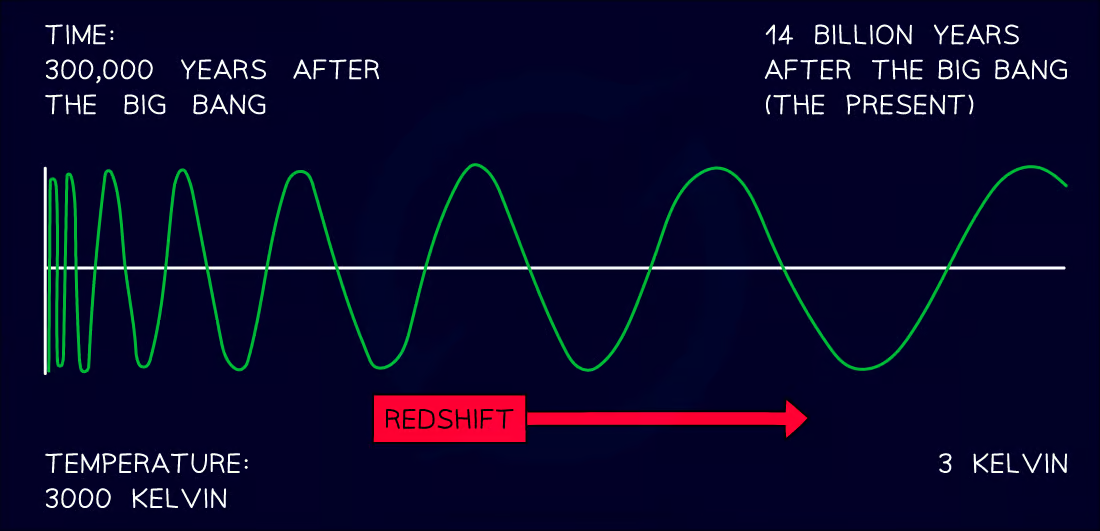
Microwave background radiation is uniform and has the exact profile expected to be emitted from a hot body that has cooled down over a very long time
This phenomenon is something that other theories (such as the Steady State Theory) cannot explain
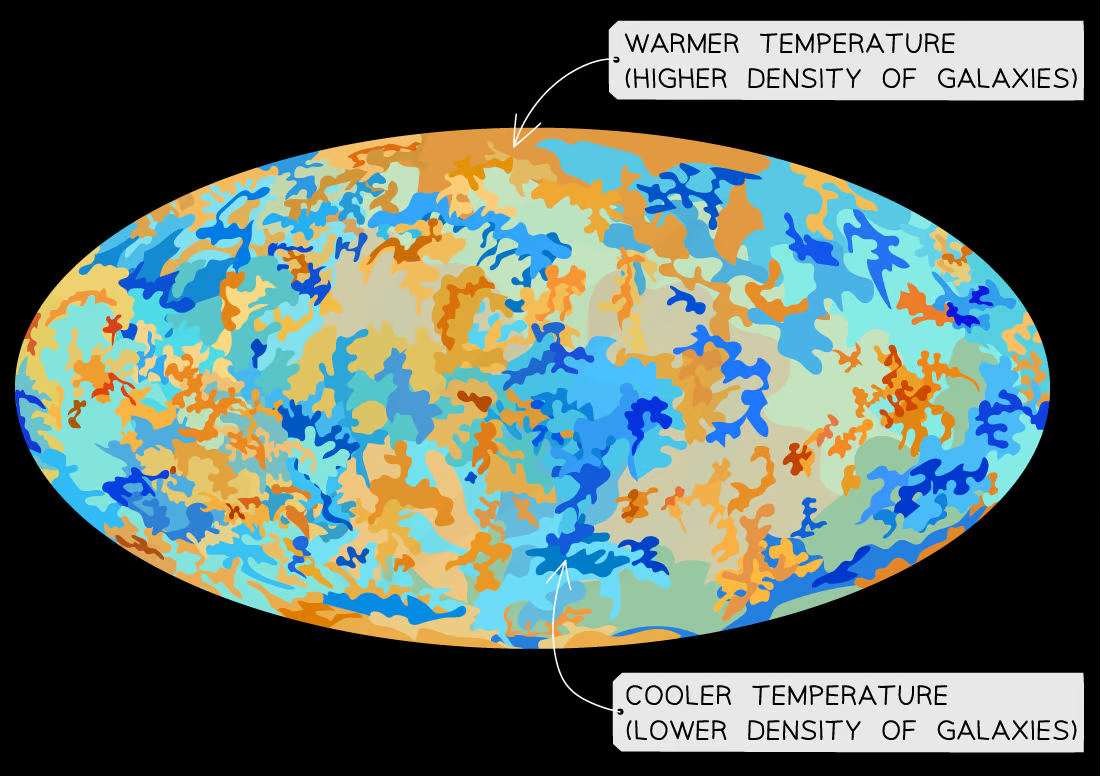
What does this diagram show?
Microwave background radiation is represented by a map of the universe
This is the closest image that exists to a map of the Universe
The different colours represent different temperatures
The red/orange/brown regions represent warmer temperatures indicating a higher density of galaxies
The blue regions represent cooler temperatures indicating a lower density of galaxies
The temperature of the microwave background radiation is mostly uniform
It has a value of 2.7 ± 0.00001 K
This implies that all objects in the Universe are uniformly spread out
The discovery of the microwave background radiation led to the Big Bang theory becoming the currently accepted model
If the universe had not started in a Big Bang then there would be no microwave background radiation
If the universe was younger than 13.7 billion years then the temperature would be higher than 2.7 K
What does general relativity state?
space and time are connected by a property known as space–time
Space–time connects the three dimensions of space (the x, y and z–axis) to a fourth dimension, which is time
The evidence suggests that the Big Bang gave rise to the expansion of space–time about ___ billion years ago
13.7
The balloon represents space and the points represent galaxies:
When the balloon is deflated, all the points are close together and an equal distance apart
As the balloon expands, all the points become further apart by the same amount
This is because the space between the galaxies has expanded
The galaxies are not actually moving through space but being carried along as space itself expands

this therefore agrees with what principle?
cosmological principle which states that the Universe is
Homogeneous (i.e. matter is uniformly distributed)
Isotropic (i.e. the Universe is the same in all directions to every observer)
What can be used the estimate the age of the universe?
Hubble’s law
v = H0d
what assumption is made in this equation?
recessional speed of a galaxy is constant over the history of the universe
We must assume that all points in the universe were initially together
If we know how far away a galaxy is from Earth and its recessional speed
We can calculate the time taken to get to reach that distance from the Earth
what is the equation used?
time = distance/ speed
H0 = v/d
Therefore:
time = 1/H0
If we say that all matter was at the same point at the very start of the Big Bang (t = 0), then the time taken for the galaxy to move to its current position will be equal to the age of the universe
In 2020, the best estimate for the Hubble constant, H0 was 67.4 km s−1 Mpc−1. Use this value to calculate the age of the universe.

As the time from the Big Bang increases the temperature of the universe _____
decreases
key stages of evolution are:
Stage 0: The Big Bang
Stage 1: Big Bang → 10–35 s after the Big Bang
Stage 2: 10–35 s after the Big Bang → 10–6 s after the Big Bang
Stage 3: 10–6 s after the Big Bang → 225 s after the Big Bang
Stage 4: 225 s after the Big Bang → 1000 years after the Big Bang
Stage 5: 1000 years after the Big Bang → 3000 years after the Big Bang
Stage 6: 3000 years after the Big Bang → 300 000 years after the Big Bang
Stage 7: 300 000 years after the Big Bang → Present
Stage 0
This is when the Big Bang occured
At this point, time and space are created
The universe is infinitely dense, hot and small, a hot singularity
Stage 1
Just after the Big Bang → 10–35 s after the Big Bang
The universe expands rapidly
This is known as inflation
There is no matter, only high energy gamma photons and electromagnetic radiation
Stage 2
This is from 10–35 s after the Big Bang → 10–6 s after the Big Bang
Building block particles come into existence (quarks, leptons, photons, and their antiparticles)
These particles cannot form heavier particles (protons and neutrons) because of the high temperatures present
There is slightly more matter than antimatter
As matter and antimatter annihilate, they leave a matter-dominated universe made from particles and not antiparticles
Stage 3
This is from 10–6 s after the Big Bang → 225 s after the Big Bang
As the universe cools protons and neutrons begin to form from quarks
Matter and antimatter continue to collide and annihilate
Producing enormous quantities of high-energy photons
These are continually absorbed and re-emitted as they interact with charged particles
Stage 4
This is from 225 s after the Big Bang → 1000 years after the Big Bang
As the universe continues to cool it behaves in the same way as the core of a star
Nuclear fusion begins
Protons and neutrons fuse to form light nuclei like deuterium, helium and lithium
Matter is in plasma form
A state in which protons and electrons are not bound to one another because of high temperatures
Rapid expansion of the universe continues until 25% of matter is helium nuclei
Stage 5
This is from 1000 years after the Big Bang → 3000 years after the Big Bang
At this time, nuclear fusion ends
Electrons are formed
Stage 6
This is from 3000 years after the Big Bang → 300 000 years after the Big Bang
The universe continues to cool and electrons combine with nuclei to form hydrogen and helium atoms
In decoupling more electrons become attached to protons
Radiation and matter separate from each other
Photons travel freely through space
The universe becomes transparent
Photons now become the microwave background radiation that we detect today
Stage 7
This is from 300 000 years after the Big Bang → Present
After about 30 million years, the first stars form
Galaxies begin to form from tiny density fluctuations because of gravitational forces pulling together clouds of hydrogen and existing stars
Billions of years later, heavy elements form from the gravitational collapse of stars
After approximately 9 billion years the solar system forms from a supernova nebula
Our Sun is formed at the centre of the nebula
Earth is formed almost 1 billion years later
Approximately 11 billion years after the Big Bang, primitive life begins on Earth
13.7 billion years after the Big Bang, the first modern humans evolve
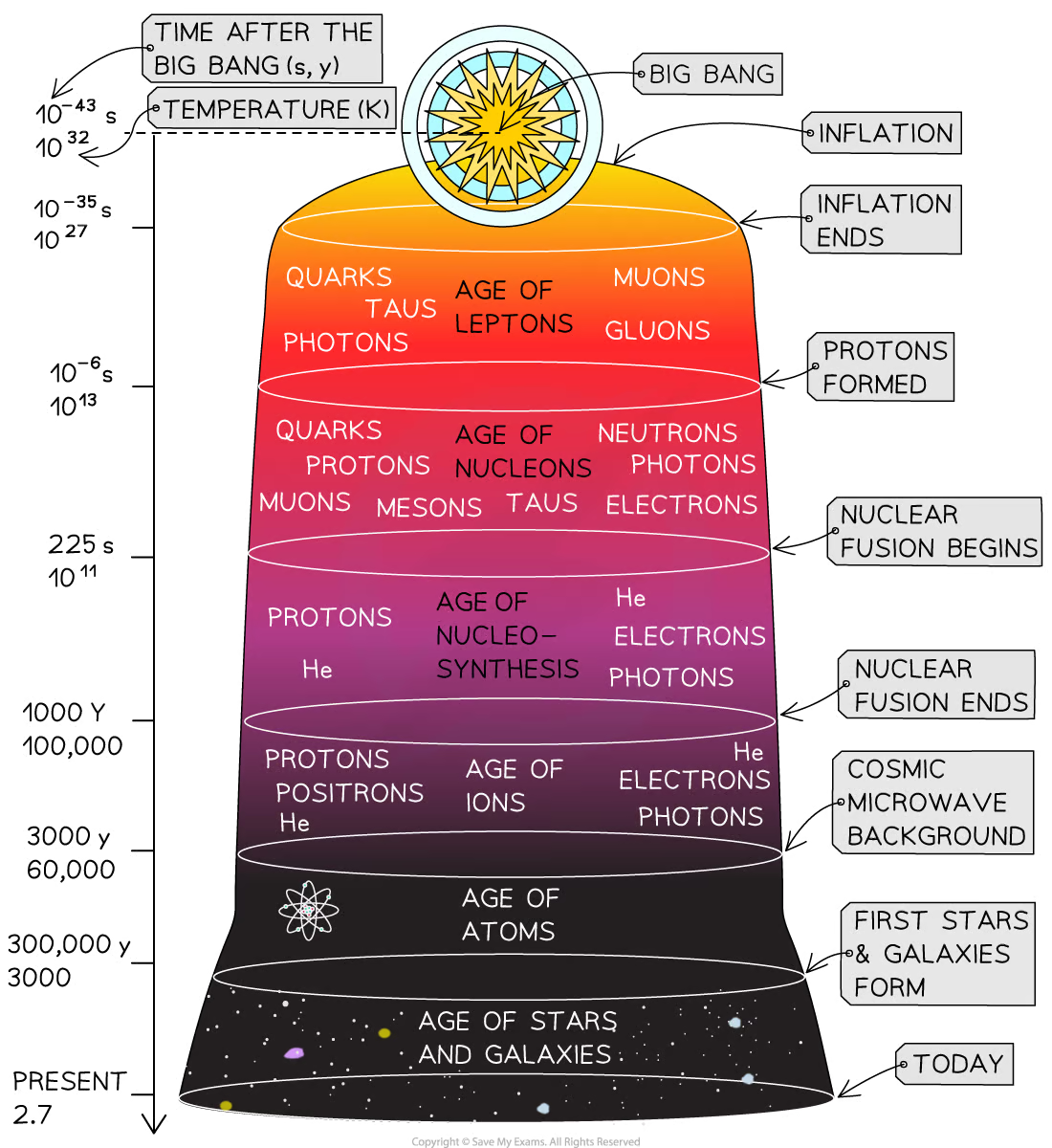
Scientists know that the universe is ________ as it expands
accelerating
______ is a hypothetical form of ____ which is used to try and explain the accelerating expansion
dark energy
energy
Dark energy is defined as:
A type of energy that permeates the whole universe and opposes the attractive gravitation force between galaxies via the exertion of a negative pressure
Dark energy cannot be _______
detected directly
It should make up ___ of the total energy in the universe
68%
Astronomers expect to observe the velocity of an object within a galaxy _____ as it moves away from the galaxy’s centre + why did they expect this?
decrease
because of weakening gravitational field strength further from the centre
This is observed in smaller mass systems, such as the in the solar system, where planets orbiting ____ from the Sun have the slowest orbital velocity
This is not the case in larger mass systems, such as entire galaxies
furthest
How is mass spread out in galaxies?
spread out
not concentrated in its centre
However…
all the observable mass of a galaxy is observed to concentrate in the centre of galaxies
what does this therefore mean?
there must be another type of matter that can't be observed- Dark Matter
Dark matter is defined as:
Matter which cannot be seen and that does not emit or absorb electromagnetic radiation
Dark matter cannot be detected directly through ______
telescopes
dark matter is estimated to make up __% of the mass in the universe
27
how is it detected?
based on its gravitational effects relating to either the rotation of galaxies or by the gravitational lensing of starlight
